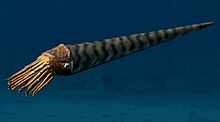
Monospecific assemblages[edit]
These orthocone cephalopods are conspicuous in the fossil record for their occasional but persistent appearances in monospecific assemblages dense enough to form individual beds of limestone that often are regional key beds. Limestones that consist of monospecific assemblages of orthocone cephalopods are known as either cephalopod beds, cephalopod limestones, nautiloid limestones, or Orthoceras limestones in the geological literature. Based on studies of size distributions of the orthocone shells, it had been argued that these assemblages likely represent post-mating mass deaths, as are common among modern cephalopods (though not modern nautiloids) and indeed among many semelparous species. More recent taphonomic and sedimentologic studies argue that such limestones are the result of the gradual accumulation of orthocone shells over an extended period of time in areas with very low rates of sedimentation and strong bottom currents. These assemblages, are known mostly from Ordovician rocks but do occur later as well, at least into the Devonian. Well-known examples occur in Morocco, Scandinavia, the Alps, and Iowa (USA).
The Baltic island of Öland off the southern coast of Sweden has many quarries that yield orthocone nautiloids of great beauty. For centuries Öland has supplied greater Europe with material for floors, stairs and grave stones. This hard limestone is durable and the fossil inclusions make it very desirable. Occasionally the chambers of the fossil shells are colored differently. The ground water minerals that percolated the strata during diagenesisdetermines the color. Greens and browns are most common.
Orthoceras grew to a length of 15 centimeters (6 inches) and fed upon small animals.
No comments:
Post a Comment